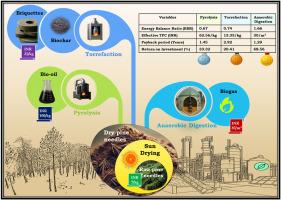松针发电的技术经济与可持续性比较研究
IF 5.8
2区 生物学
Q1 AGRICULTURAL ENGINEERING
引用次数: 0
摘要
对一个假设的放大系统(每天1.5吨)进行了全面的技术经济分析(TEA),以能源投入、生物燃料产量和经济可行性为基础,比较这三种途径。采用物化预处理和共消化的1.5吨/日沼气装置的能量输入为2369千瓦时/吨,每天产生586立方米甲烷(CH4)。在577℃条件下,1.5 TPD的热解装置可生产405 kg生物油和585 kg生物炭,每吨原料的总能量输入为7846 kW h。1.5 TPD的焙烧装置,在350°C下加热60分钟,每吨生物质需要8814千瓦时的输入能量,产生829公斤的型煤。经济分析表明,厌氧消化的年利润为1152.8万印度卢比,生产成本为30印度卢比/m3,投资回收期为1.29年;热解和热解的年利润分别为51.64万印度卢比和268.3万印度卢比,生产成本为62.56印度卢比/kg,投资回收期分别为1.45年和2.92年。盈利指标和成本分布强调原料成本、能源消耗和产品市场价格显著影响盈利能力。在这三种途径中,厌氧消化是最经济可行的选择,投资回报率(ROI)为68.56%。基于实验室规模和实验规模的数据,本研究强调了TEA对商业可扩展性的需求。本文章由计算机程序翻译,如有差异,请以英文原文为准。

A comparative study on pine needle-based energy generation: Perspectives on techno-economics and sustainability
A comprehensive techno-economic analysis (TEA) was conducted for a hypothetically scaled up system (1.5 ton per day) to compare these three pathways based on energy input, biofuel yield, and economic viability. The energy input for a 1.5 ton per day (TPD) biogas plant with physicochemical pretreatment and co-digestion was 2369 kW h/ton, generating 586 m3 of methane (CH4) daily. The 1.5 TPD pyrolysis plant working at 577 °C yields 405 kg bio-oil and 585 kg biochar with a total energy input of 7846 kW h per ton of feedstock. The 1.5 TPD torrefaction plant, at 350 °C for 60 min, generates 829 kg of briquettes requiring input energy of 8814 kW h per ton of biomass. Economic analysis indicates that anaerobic digestion achieved a profit of INR 115.28 lakh per annum with a production cost of INR 30/m3, and a payback period of 1.29 years, while pyrolysis and torrefaction exhibited profits of INR 51.64 lakh and INR 26.83 lakh yearly, with a production cost of INR 62.56/kg and INR 13.33/kg having corresponding payback in 1.45 and 2.92 years, respectively. Profitability metrics and cost distribution highlight that feedstock cost, energy consumption, and product market prices significantly influence profitability. Among the three pathways, anaerobic digestion is the most economically viable option, with a Return on Investment (ROI) of 68.56 %. This study emphasizes the need of TEA for commercial scalability based on the data of lab scale and bench scale.
求助全文
通过发布文献求助,成功后即可免费获取论文全文。
去求助
来源期刊

Biomass & Bioenergy
工程技术-能源与燃料
CiteScore
11.50
自引率
3.30%
发文量
258
审稿时长
60 days
期刊介绍:
Biomass & Bioenergy is an international journal publishing original research papers and short communications, review articles and case studies on biological resources, chemical and biological processes, and biomass products for new renewable sources of energy and materials.
The scope of the journal extends to the environmental, management and economic aspects of biomass and bioenergy.
Key areas covered by the journal:
• Biomass: sources, energy crop production processes, genetic improvements, composition. Please note that research on these biomass subjects must be linked directly to bioenergy generation.
• Biological Residues: residues/rests from agricultural production, forestry and plantations (palm, sugar etc), processing industries, and municipal sources (MSW). Papers on the use of biomass residues through innovative processes/technological novelty and/or consideration of feedstock/system sustainability (or unsustainability) are welcomed. However waste treatment processes and pollution control or mitigation which are only tangentially related to bioenergy are not in the scope of the journal, as they are more suited to publications in the environmental arena. Papers that describe conventional waste streams (ie well described in existing literature) that do not empirically address ''new'' added value from the process are not suitable for submission to the journal.
• Bioenergy Processes: fermentations, thermochemical conversions, liquid and gaseous fuels, and petrochemical substitutes
• Bioenergy Utilization: direct combustion, gasification, electricity production, chemical processes, and by-product remediation
• Biomass and the Environment: carbon cycle, the net energy efficiency of bioenergy systems, assessment of sustainability, and biodiversity issues.
 求助内容:
求助内容: 应助结果提醒方式:
应助结果提醒方式:


